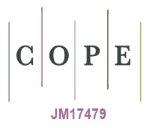Preparation and Characterization of Polylactic Acid by Ring Opening Polymerization Using Unconventional Heating System
DOI:
https://doi.org/10.23851/mjs.v33i2.1119Keywords:
polylactic acid, microwave techniques, biodegradable polymers, green chemistryAbstract
Polylactic acid (PLA) has been synthesized via ring opening polymerization (ROP) for the Lactide cyclic dimmer under microwave irradiation with a constant power of 300W using ZnO catalyst. The structural formula of PLA was established using spectroscopic techniques FTIR, 1HNMR, and 13CNMR. The thermal properties were investigated using DSC and TGA techniques. The DSC thermogram exhibited two endothermic transitions at (115-132) C° which related to the melting of the polymer, while the TGA thermogram showed one main decomposition step at 265°C. The viscosity average molecular weight [] of the obtained polymer was (7.8×103 gm/mol). The SEM morphology study exhibited homogenous and dense surface with no separate entities
Downloads
References
Liu C, Jia Y, He A. Preparation of higher molecular weight poly (L -lactic acid) by chain extension. Int. J. Polym. Sci. 2013;2013:1-7.
Konoplev I, Kozlovskiy R, Shvets V, et al. Purification of crude lactide to polymerization grade purity by molt recrystallization method. Asian J. Chem. 2017;29(8):1797-1802.
Díaz-Galindo EP, Nesic A, Cabrera-Barjas G, et al. Physico-chemical and anti adhesive propertiesof poly(Lactic acid)/grapevine cane extract films against foodpathogenic microorganisms. Polymers (Basel). 2020;12(12):1-15
Elsawy MA, Kim KH, Park JW, Deep A. Hydrolytic degradation of polylactic acid (PLA) and its composites. Renew. Sustain. Energy Rev. 2017;79(April):1346-1352.
Behera K, Chang YH, Chiu FC, Yang JC. Characterization of poly(lactic acid)s with reduced molecular weight fabricated through an autoclave process. Polym. Test. 2017;60(March):132-139.
Karande RD, Abitha V, Rane A V, Mishra RK. Preparation of Polylactide from Synthesized Lactic Acid and Effect of reaction Parameters on Conversion. J. Mater. Sci. Eng. with Adv. Technol. 2015;12(1):1-37. Available at:
https://www.researchgate.net/publication/311909674
Sha L, Chen Z, Chen Z, Zhang A, Yang Z. Polylactic acid based nanocomposites: Promising safe and biodegradable materials in biomedical field. Int. J. Polym. Sci. 2016;2016.
Lopes MS, Jardini AL, Filho RM. Synthesis and characterizations of poly (lactic acid) by ring-opening polymerization for biomedical applications. Chem. Eng. Trans. 2014;38:331-336.
Carothers, W. H., Dorough, G. L., & Natta F V. No Title. Am. Chem. Soc. 1932;54(2):761-772.
E.: L. No TitlePreparation of high molecular weight poly hydroxyl acetic ester. U.S. Pat. 2668162 A, USA. 1954.
Jiang W, Huang W, Cheng N, et al. Isotactic polycondensation of l-lactic acid with biogenic creatinine. Polymer (Guildf)2012;53(24):5476-5479.
Fang L, Qi R, Liu L, Juan G, Huang S. Synthesis of poly(L-lactide) via solvothermal method. Int. J. Polym. Sci. 2009;2009.
Nuyken O, Pask SD. Ring-opening polymerization-An introductory review. Polymers (Basel). 2013;5(2):361-403.
Balla E, Daniilidis V, Karlioti G, et al. Poly(lactic acid): A versatile biobased polymer for the future with multifunctional properties-from monomer synthesis, polymerization techniques and molecular weight increase to PLA applications. Polymers (Basel). 2021;13(11).
Garlotta D. A literature review of poly(lactic acid). J. Polym. Environ. 2001;9(2):63-84.
Auras R., Lim T., Selke M., Tsuji H.: .Wiley NJ. Poly(lactic acid):Synthesis, structures, properties, processing, and applications.Wiley, New Jersey (2010). 2010.
Dubey S, Abhyankar H, Marchante V, Brighton J, Blackburn K. Chronological Review of the Catalytic Progress of Polylactic Acid Formation through Ring Opening Polymerization. Int. Res. J. Pure Appl. Chem. 2016;12(3):1-20.
Hu Y, Daoud WA, Cheuk KKL, Lin CSK. Newly developed techniques on polycondensation,ring-opening polymerization and polymer modification: Focus on poly(lactic acid). Materials (Basel). 2016;9(3).
Xiao L, Wang B, Yang G, Gauthier M. Poly(Lactic Acid)-Based Biomaterials: Synthesis, Modification and Applications. Biomed.Sci. Eng. Technol. 2012;(January).
Dong KY, Kim D, Doo SL. Reaction kinetics for the synthesis of oligomeric poly(lactic acid). Macromol. Res. 2005;13(1):68-72.
Acid P, Li G, Zhao M, et al. Synthesis and Biological Application of. 2020.
Icart LP, Fernandes E, Agüero L, et al. End functionalization by ring opening polymerization: Influence of reaction conditions on the synthesis of end functionalized poly(lactic acid). J. Braz. Chem. Soc. 2018;29(1):99-108.
Pang X, Zhuang X, Tang Z, Chen X. Polylactic acid (PLA): Research, development and industrialization. Biotechnol. J. 2010;5(11):1125-1136.
Chisholm MH. Concerning the ring-opening polymerization of lactide and cyclic esters by coordination metal catalysts. Pure Appl. Chem. 2010;82(8):1647-1662.
Żółtowska K, Sobczak M, Ole¸dzka E. Novel zinc-catalytic systems for ring-opening polymerization of ε-caprolactone. Molecules. 2015;20(2):2816-2827.
Boua-In K, Chaiyut N, Ksapabutr B. Preparation of polylactide by ring-opening polymerisation of lactide. Optoelectron. Adv. Mater. Rapid Commun. 2010;4(9):1404-1407.
Sungyeap Hong CL. An Overview of the Synthesis and Synthetic Mechanism of Poly (Lactic acid). Mod. Chem. Appl. 2014;02(04).
Singla P, Kaur P, Mehta R, Berek D, Upadhyay SN. Ring-Opening Polymerization of Lactide Using Microwave and Conventional Heating. Procedia Chem. 2012;4:179-185.
Wang-xi Zhang and Yan-zhi Wang. Synthesis and properties of high molecular weight poly(lactic acid) and its resultant fibers. Chinese J. Polym. Sci. 2008;26,(4):425−432.
Gangrade D, Sd L, Al M. Overview on microwave synthesis - Important tool for green Chemistry. Int J Res Pharm Sci. 2015;5(2):37-42. Available at: www.ijrpsonline.com.
Ravichandran S, Karthikeyan E. Microwave synthesis - A potential tool for green chemistry. Int. J. ChemTech Res. 2011;3(1):466-470.
L. J. Liu, C. Zhang, L. Q. Liao XLW and RXZ. Microwave-assisted polymerization of D, L-lactide with stannous octanoate as catalyst . Chin. Chem. Lett. 2001;12((8)):663-664.
S. Jing, W. Peng ZT and ZB. Microwaveirradiated ring-opening polymerization of D,L-lactide under atmosphere,. J. Appl. Polym. Sci.,. 2006;100(3):2244-2247.
Gong S., Zhang C. LL. Microwave-assisted synthesis of PLLA-PEG-PLLA triblock copolymers. Macromol. Rapid Commun. ;. 2007;28:422-427.
Nayak J, Devi C, Vidyapeeth L. Microwave assisted synthesis : a green chemistry approach. Int. Res. J. Pharm. Appl. Sci. 2016;3(5):278-285.
Ristić I, Jotanović M, Erceg T, et al. The influence of reaction time on the properties of microwave synthesized poly(lactide). Contemp. Mater. 2019;10(1):56-63.
Zhang C, Liao L, Liu L. Rapid ring-opening polymerization of D,L-lactide by microwaves. Macromol. Rapid Commun. 2004;25(15):1402-1405.
Veitía MSI, Ferroud C. New activation methods used in green chemistry for the synthesis of high added value molecules. Int. J. Energy Environ. Eng. 2015;6(1):37-46.
Kaur P. constant Determination of Mark-Houwink Parameters for Polylactide. ournal Emerg. Technol. Innov. Res. 5(6):52-57.
Yoo DK, Kim D, Lee DS. 70.Macromol.Res.2006;14(5):510-516.
S.Inkinen et al. From Lactic Acid to Poly(lactic acid) (PLA): Characterization and Analysis of PLA and Its Precursors,. Biomacromolecules,. 12(3):523-532.
Jing, Shu Wang Peng, Zhang Yingmin and MX. Rapid Melt Polycondensation of L-Lactic Acid under Microwave Irradiation. Macromol. Res. 2006;14,(6):659-662.
Downloads
Key Dates
Published
Issue
Section
License
Copyright (c) 2022 Al-Mustansiriyah Journal of Science

This work is licensed under a Creative Commons Attribution-NonCommercial 4.0 International License.
(Starting May 5, 2024) Authors retain copyright and grant the journal right of first publication with the work simultaneously licensed under a Creative Commons Attribution (CC-BY) 4.0 License that allows others to share the work with an acknowledgement of the work’s authorship and initial publication in this journal.






















